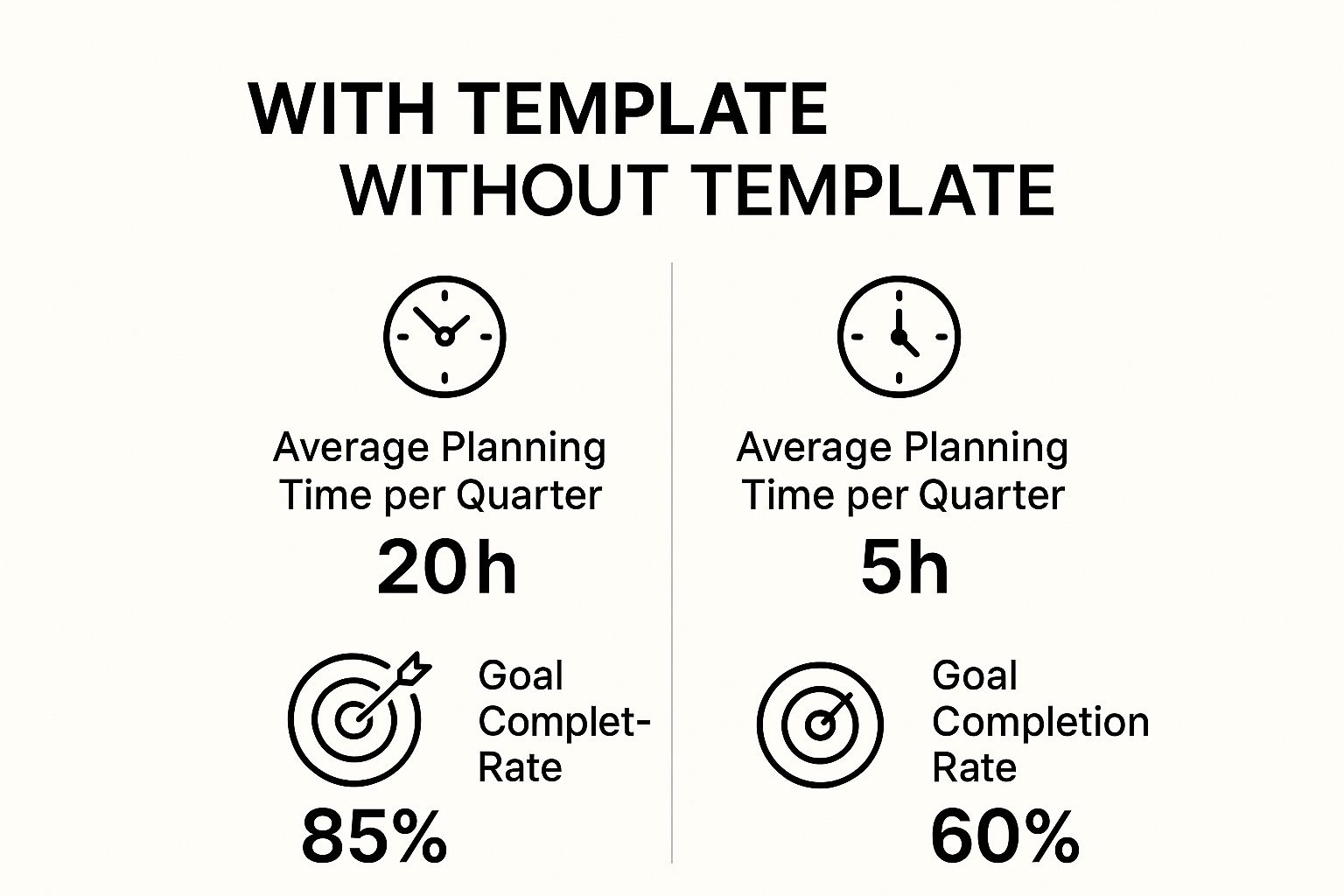
Master Your Workflow with Our Quarterly Planning Template
Share
Why Quarterly Planning Templates Transform Business Results
The gap between annual strategy and daily tasks can be a real stumbling block for businesses. Think of your annual plan as a cross-country road trip: you know the destination, but without a detailed map and regular check-ins, you risk getting lost. Quarterly planning acts as your GPS, providing direction and the flexibility to adjust to changing conditions. A well-structured quarterly plan bridges the gap between long-term vision and daily action.
Quarterly planning templates provide a structured framework for setting and achieving goals within a shorter timeframe. This allows businesses to be more agile and responsive to market shifts, unlike annual plans, which can quickly become outdated. These templates also help address common execution problems like misaligned teams, scattered resources, and difficulty tracking progress.
For example, imagine a marketing team with an annual goal to increase leads by 50%. Without quarterly checkpoints, it's easy to lose momentum. A quarterly planning template helps break down that overarching goal into smaller, more manageable milestones. This keeps everyone focused and aligned, resulting in more effective execution.
This structured approach is becoming increasingly standard. In strategic business planning, quarterly planning templates enhance execution and team alignment, especially in major markets. Platforms like Miro offer over 165 strategy and planning templates, including those for quarterly cycles, enabling a smooth transition from strategy to execution. Explore Miro templates. This trend highlights the growing recognition of structured planning’s importance for organizational performance and agility in volatile markets.
Overcoming Resistance to Quarterly Planning
Teams accustomed to less structured approaches may resist quarterly planning, viewing it as an added burden. Leaders can overcome this resistance by emphasizing the benefits: increased clarity, accountability, and the potential for improved results. When teams understand how quarterly planning can simplify their work and improve outcomes, they're more likely to embrace the change.
Creating Accountability That Sticks
Quarterly planning templates establish clear roles and responsibilities, ensuring everyone understands their contribution to the quarterly objectives. This shared understanding fosters ownership and motivates individuals to achieve their targets. Regular progress reviews further reinforce accountability and keep everyone on track. This transparent approach allows for quick identification and resolution of any roadblocks, maximizing the chances of success.
The Power of Measurable Progress
Quarterly planning templates facilitate measurable progress by focusing on SMART goals (Specific, Measurable, Attainable, Relevant, and Time-bound). This enables accurate tracking and analysis of Key Performance Indicators (KPIs), providing valuable insights into what's working and what needs adjustment. This data-driven approach leads to continuous improvement and better business outcomes. Consistently evaluating and refining quarterly plans based on data helps businesses adapt and thrive.
Building a Quarterly Planning Template That Actually Works
Too many quarterly planning templates prioritize aesthetics over function. They look great, but often fail to deliver practical results. This section explores the essential components of truly effective quarterly planning templates, emphasizing tangible results over visual appeal.
Essential Components for Success
A strong quarterly planning template needs several key elements working together to create a comprehensive, actionable plan that allows for easy progress tracking.
-
Clear Objectives: Begin by defining Objectives and Key Results (OKRs) or SMART goals. These give clear direction for the quarter, ensuring everyone works towards the same overarching goals. For example, an objective could be "Increase brand awareness," with a key result of "Increase social media followers by 20%."
-
Resource Allocation: A dedicated section for resource allocation prevents teams from overcommitting and ensures strategic alignment of resources with objectives. This includes budgeting, personnel, and time management.
-
Risk Assessment: Anticipate potential problems with a risk assessment matrix. Identify and evaluate potential challenges, develop mitigation strategies, and assign ownership for addressing those risks.
-
Accountability System: Establish clear roles, responsibilities, and reporting procedures. This creates ownership and accountability without micromanaging, promoting consistent execution.
Visualizing the Impact
The following infographic shows the difference a well-structured quarterly planning template can make to both planning efficiency and achieving goals. It compares average planning time and goal completion rates for teams using a template versus those without.

As the infographic demonstrates, using a template drastically reduces planning time (from 20 hours to 5 hours) while significantly improving goal achievement (from 60% to 85%). This highlights the value of a structured approach to quarterly planning. For further insights, explore resources like How to master....
Structuring Your Template For Action
Visual organization is crucial. A cluttered template can be counterproductive. Prioritize clarity and ease of use. Use headings, subheadings, bullet points, and tables to present information clearly and concisely. This keeps your template a practical tool, not a burdensome document.
The table below details the key components of an effective quarterly planning template.
A well-structured template provides a roadmap for success, enabling teams to focus on execution and achieve their objectives. A solid foundation for any business venture often begins with a shared understanding of expectations. Using a founder's agreement template can ensure everyone is aligned from the outset.
Essential Components of Quarterly Planning Templates
| Component | Purpose | Implementation Tips | Common Pitfalls |
|---|---|---|---|
| Clear Objectives | Define the desired outcomes for the quarter. | Use OKRs or SMART goals. | Lack of specific, measurable goals. |
| Resource Allocation | Assign resources strategically to support objectives. | Include budget, personnel, and time allocations. | Overcommitting resources or misalignment with objectives. |
| Risk Assessment | Identify and mitigate potential challenges. | Use a risk assessment matrix. | Failing to anticipate or address potential roadblocks. |
| Accountability System | Establish clear roles and responsibilities. | Define reporting mechanisms and review progress regularly. | Lack of clarity around ownership and responsibilities. |
This table summarizes the core elements of a successful quarterly planning template, offering guidance on their implementation and highlighting potential problems to avoid.
Implementation Based on Company Size
Template complexity should match your company’s size and structure. A small startup might need a simple one-page document, while a large corporation may require a more detailed, multi-page template.
Warning Signs of a Weak Template
Several red flags signal that your template might be missing key elements:
-
Lack of Measurable Goals: If goals aren’t quantifiable, tracking progress becomes impossible.
-
Unclear Responsibilities: Ambiguity around roles leads to confusion and inaction.
-
No Risk Mitigation Strategies: Failing to anticipate problems can derail your plans.
Addressing these issues strengthens your template and contributes to more successful quarterly planning. This proactive approach helps teams navigate challenges and maximize their potential for achieving objectives. The ultimate goal is to create a dynamic planning system that drives progress and delivers results. A well-structured quarterly planning template is essential for this process.
Customizing Quarterly Templates For Your Industry
A generic quarterly planning template offers a solid foundation. However, to truly unlock its potential, you need to customize it for your specific industry. A one-size-fits-all approach overlooks the unique challenges and opportunities presented to different sectors. Just as a marketing plan for a tech startup wouldn't work for a manufacturing company, a generic quarterly planning template requires tailoring. Think of it as a suit – a bespoke version always fits better than something off the rack.
Industry-Specific Adaptations
Different industries operate on different timelines, face varying regulations, and prioritize different metrics. This necessitates adjustments to your quarterly planning template.
-
Tech: Fast-paced industries like tech often require shorter planning horizons and increased flexibility. They might focus on product iteration cycles and user acquisition metrics.
-
Manufacturing: Manufacturing businesses must consider supply chain dynamics, production lead times, and inventory management. Their templates should include sections for resource planning and logistics.
-
Healthcare: Healthcare organizations must adhere to stringent regulations and compliance standards. Their planning needs to integrate compliance milestones and patient outcome metrics.
This tailored approach ensures your template addresses your industry's specific rhythms and demands. You might be interested in: How to master....
Defining Key Performance Indicators (KPIs)
The metrics that matter most vary by industry. A tech company might focus on website traffic and conversion rates, while a manufacturing company prioritizes production efficiency and defect rates. Identifying your key performance indicators (KPIs) is crucial for customizing your quarterly planning template. Including the right KPIs allows for accurate progress tracking and informed decision-making.
Incorporating Regulatory Factors
Many industries operate within strict regulatory environments. Healthcare, finance, and energy sectors, for example, face significant compliance requirements. Your quarterly planning template should incorporate these regulations to ensure your plans remain compliant and avoid potential legal issues. This proactive approach mitigates risk and streamlines operations by integrating compliance considerations from the outset.
Aligning With Industry Cycles
Some industries have distinct cyclical patterns. Retail, for instance, experiences peak seasons around holidays. Aligning your quarterly planning with these industry-specific cycles ensures your plans capitalize on opportunities and prepare for predictable challenges. This forward-looking approach optimizes resource allocation and maximizes the potential for achieving quarterly goals.
Quarterly planning templates are vital not just in corporate settings, but also in government financial planning. The International Monetary Fund (IMF) emphasizes the importance of standardized quarterly data templates, especially for countries with decentralized government structures, ensuring reliable and timely financial reporting. Discover more insights about quarterly government finance statistics.
From Generic To Powerful: Real-World Examples
Numerous companies have successfully transformed generic quarterly planning templates into powerful, industry-specific tools. For example, a software company customized its template to incorporate sprint cycles and user feedback loops, leading to a 20% reduction in development time. Similarly, a retail company integrated seasonal sales trends into its template, resulting in a 15% increase in quarterly revenue.

These successes underscore the significant performance improvements achievable through customizing quarterly planning templates. By tailoring your template to your specific needs, you can achieve similar impressive results. The key takeaway is that adapting your template is an investment in better planning and improved outcomes.
Turning Your Template Into a Powerful Planning Process
A well-crafted quarterly planning template is a great tool. But its real power lies in how you use it. It’s not just a document; it’s the starting point for a dynamic planning process. This section shows you how to implement quarterly planning that energizes your team, not burdens them with extra work.
Pre-Quarter Preparation: Setting the Stage for Success
Effective quarterly planning begins even before the quarter starts. This crucial preparation phase sets the stage for productive planning sessions. It also makes sure everyone is on the same page. Begin by reviewing the last quarter’s performance. Analyze what worked, what didn't, and any obstacles you encountered. This review provides important insights for setting realistic goals for the upcoming quarter.
Next, get input from key stakeholders across various departments. This collaborative approach ensures everyone is aligned from the beginning and builds a shared understanding of your company’s strategic direction. This pre-planning stage also involves defining clear objectives for the quarter, aligned with your overall yearly goals. Setting clear expectations upfront keeps you focused on the bigger picture and prevents you from straying from your strategy.
Facilitating Effective Planning Sessions
The planning session itself is where your template truly comes to life. This is more than just filling in the blanks. It’s about discussion and creating meaningful commitments. Start by outlining the objectives and key results for the quarter. This ensures everyone understands what needs to be achieved.
Encourage open communication and brainstorming during the session. This creates a sense of ownership among team members and encourages innovative solutions. Then, translate those high-level objectives into actionable tasks and assign responsibilities. This detailed approach makes sure everyone knows their role in reaching those quarterly goals.
Don’t just assign tasks, allocate resources too. This ensures teams have the necessary budget, staff, and time to succeed. A plan without resources is just a wish list.
Building Accountability Systems that Drive Execution
Accountability is what drives consistent execution. Without it, even the best plans will fail. Set up regular progress review meetings. These check-ins allow you to monitor progress, identify roadblocks, and make any necessary adjustments. Use project management tools or platforms to monitor tasks and deadlines. These tools promote transparency and keep everyone updated on the project's status.
Also, celebrate milestones and recognize successes. This positive reinforcement keeps teams motivated and fosters a culture of achievement. Remember, plans change. Be ready to adapt as circumstances evolve. This adaptable approach helps ensure your quarterly planning stays relevant and effective for driving your business forward.

Overcoming Common Challenges
Implementing quarterly planning isn’t always easy. Some teams may resist a structured approach, others may struggle to keep up the momentum. Address any resistance by communicating the advantages of quarterly planning. Explain how it streamlines work, sharpens focus, and generates better results. Inconsistent use across different teams can also hinder progress. Provide training and support to ensure consistent implementation, helping everyone understand and utilize the template effectively.
Finally, maintaining momentum throughout the quarter can be tough. Regularly review progress and celebrate wins. This keeps teams engaged and motivated, especially when facing unexpected obstacles. By addressing these common implementation challenges, you can guarantee that your quarterly planning process stays a valuable asset for achieving your business goals. Continuously refining and adapting ensures its relevance and effectiveness in driving success.
To help with implementation, review this quarterly planning timeline:
Quarterly Planning Implementation Timeline
This timeline outlines the key activities, responsibilities, and deadlines for implementing a quarterly planning process with your template.
| Timeframe | Activities | Responsible Parties | Deliverables |
|---|---|---|---|
| Pre-Quarter | Review previous quarter performance, Gather stakeholder input, Define quarterly objectives | Leadership Team, Department Heads | Performance analysis, Stakeholder feedback, Defined objectives |
| Planning Session | Outline objectives and key results, Facilitate brainstorming, Assign tasks and resources | Leadership Team, Project Managers | Agreed-upon objectives, Actionable tasks, Resource allocation |
| During Quarter | Regular progress review meetings, Monitor tasks and deadlines, Celebrate milestones | Project Managers, Team Members | Progress reports, Task updates, Milestone achievements |
| Post-Quarter | Review quarterly results, Identify areas for improvement, Adapt plan for next quarter | Leadership Team, Department Heads | Performance review, Improvement plan, Updated plan |
This table summarizes the key stages of quarterly planning, highlighting the crucial steps involved in each stage, from preparation and execution to review and adaptation. By following this timeline and focusing on these key aspects, you can establish a robust and effective quarterly planning process.
Digital Tools That Supercharge Quarterly Planning Templates
Beyond basic spreadsheets, numerous digital tools can transform quarterly planning. They shift static documents into dynamic, collaborative systems. This empowers teams to move beyond simply outlining goals. Instead, they can actively track progress, adapt to change, and achieve better results. This section evaluates the platforms leading organizations use to amplify their quarterly planning impact. We'll explore options ranging from specialized project management software to broader enterprise-level systems.
Specialized Project Management Platforms
Tools like Asana and Monday.com offer robust features. These features are specifically designed for managing projects and tracking progress. This makes them ideal for implementing quarterly plans. These platforms provide real-time progress tracking. This allows teams to see exactly where they stand against their objectives at any given moment. This transparency promotes accountability. It also enables swift adjustments if plans veer off course.
Additionally, these tools often include automation capabilities. This streamlines repetitive tasks and frees up time for more strategic work. For example, automated reminders can prompt team members to update their progress. They can also notify stakeholders of upcoming deadlines. These platforms also frequently incorporate visualization dashboards. These dashboards transform raw data into easily digestible charts and graphs. This visual representation of progress helps teams quickly grasp key insights and communicate updates effectively.
-
Key Features of Asana and Monday.com:
- Real-time progress tracking
- Automation capabilities
- Visualization dashboards
- Collaboration features
Enterprise-Level Systems and Integrations
Larger organizations often benefit from integrating quarterly planning with broader enterprise systems. This connection links high-level strategic goals with daily operational activities. This creates a unified workflow. Integrating quarterly planning templates with existing CRM (Customer Relationship Management) or ERP (Enterprise Resource Planning) systems, for instance, ensures everyone is working from the same data. It also aligns everyone toward the same overarching business goals. This unified approach eliminates data silos. It strengthens strategic alignment across all departments.
Implementation and Data Migration
Successfully digitizing your quarterly planning process involves several key considerations. First, maximize adoption rates by providing thorough training and ongoing support to your team. Clearly communicate the benefits of these new tools and address any concerns proactively.
Second, consider data migration strategies. Preserving historical planning insights is critical for informing future strategies. Ensure your chosen platform allows seamless import of existing data from previous templates or systems. This continuity maintains valuable context. It supports informed decision-making. Check out our guide on How to master... for additional insights on effectively utilizing planning templates.
Finally, think about how your new digital tools integrate with existing work management systems. Seamless integration between platforms minimizes disruption. It maximizes efficiency by connecting quarterly plans to daily tasks and workflows. This unified approach ensures your quarterly goals translate into concrete actions.
Cost and Timelines
Each platform has different cost structures and implementation timelines. Specialized project management tools typically have subscription-based pricing models. Integrating with enterprise-level systems may involve more complex implementation processes and associated costs. When evaluating options, consider realistic cost considerations and implementation timelines based on actual company experiences within your industry and size. This diligence helps avoid unforeseen expenses and ensures a smooth transition.
By carefully evaluating these factors, you can choose the right digital tools. These tools can transform your quarterly planning template into a powerful engine for growth. The right platform empowers teams to collaborate more effectively. It helps them track progress in real-time and ultimately achieve better business results. This strategic adoption of digital tools elevates quarterly planning. It takes it from a static process to a dynamic driver of organizational success.
Real-World Quarterly Planning Template Success Stories
While understanding the elements of a robust quarterly planning template is crucial, seeing real-world success stories offers invaluable practical insights. These examples show how organizations leverage these tools to tackle challenges and achieve measurable results. This section explores case studies demonstrating the practical application and advantages of quarterly planning templates.
High-Growth Tech Company Maintains Alignment During Rapid Expansion
Imagine a tech startup experiencing rapid growth. Adding team members quickly (a 215% increase) can often lead to communication breakdowns and misaligned priorities. One company used a quarterly planning template to address this. The template focused on clearly defined Objectives and Key Results (OKRs), ensuring everyone understood the company's top priorities for the quarter. It also included detailed resource allocation to prevent overcommitment and maintain strategic alignment. The result? The company maintained strong team cohesion and consistently hit targets, despite the rapid expansion.
Manufacturing Business Reduces Strategic Drift
Strategic drift, the gradual deviation from a company's long-term goals, can significantly hinder performance. One manufacturing business faced this issue, with departments becoming increasingly siloed. They implemented a quarterly planning template that emphasized regular progress reviews and clear accountability. The template incorporated a risk assessment matrix to identify potential roadblocks and develop mitigation strategies proactively. Consistent use of the template led to a 68% reduction in strategic drift, demonstrating the power of structured planning. You might be interested in exploring our blog articles related to planning and achieving goals.
Professional Services Firm Increases Project Profitability
For professional services firms, aligning client deliverables with internal objectives is key for profitability. One such firm struggled with this, resulting in project overruns and reduced profit margins. They implemented a quarterly planning template that directly linked client projects to quarterly objectives. This template included sections for tracking project milestones and budget allocation. By focusing on this alignment, the firm increased project profitability, showcasing how the template effectively connected overall strategy to client work. To enhance your own planning, consider the range of digital customer service tools for collaboration and project management.
The Importance of Standardization
The value of standardized quarterly planning and reporting is evident across industries. In 2024, the Institutional Limited Partners Association (ILPA) advanced the use of these templates in private equity. The ILPA Quarterly Reporting Standards Initiative (QRSI) involved over 250 organizations globally, resulting in updated reporting and performance templates. The anticipated adoption rate for the updated reporting template is over 68%. This highlights the growing recognition of standardized templates for improved transparency and informed decision-making in private equity. More details on this initiative are available here.

These examples illustrate how strategically implementing quarterly planning templates can significantly improve business outcomes across various industries. By adapting these templates to specific organizational needs and focusing on consistent execution, companies can achieve impressive results. This underscores the potential of structured quarterly planning for driving growth and achieving success.
Evolve Your Quarterly Planning Template Over Time
Your quarterly planning template shouldn't remain static. Instead, treat it as a dynamic tool that adapts and grows alongside your business. Just as a gardener tends to their plants, you need to regularly nurture and refine your template to ensure it continues producing positive results. This requires ongoing evaluation and a commitment to continuous improvement.
Gathering Feedback and Analyzing Data
Effective evolution begins with gathering feedback from the people who actually use the template. This provides valuable insights into its effectiveness, highlighting what works well, what doesn't, and where improvements can be made. Several methods can be employed to gather this feedback:
- Surveys: Anonymous surveys offer a safe space for candid feedback.
- Interviews: One-on-one interviews provide a deeper understanding of individual user experiences.
- Focus Groups: Group discussions can uncover shared challenges and potential solutions.
In addition to feedback, analyze your goal achievement patterns. Did you consistently meet, exceed, or fall short of your quarterly targets? Understanding these patterns helps identify the template's strengths and weaknesses. For instance, consistently overestimating your capacity suggests that the resource allocation section might need adjustments.
Furthermore, identify recurring obstacles. Are there specific challenges that continually impede progress? These recurring issues could point to weaknesses in your template's risk assessment or accountability sections. Analyzing data and feedback allows you to pinpoint areas for improvement and refinement.
Balancing Consistency and Evolution
Finding the right balance between consistency and evolution is essential. Consistency helps establish routine and makes the planning process more efficient. However, evolution ensures your template remains relevant and adaptable to changing business needs. One effective strategy is template versioning.
Creating new template versions while archiving older ones maintains a record of past approaches. This creates a valuable archive of institutional knowledge, allowing for continuous learning and improvement. Similar to software updates, you gain the benefits of new features while retaining the core functionality that makes the system effective.
Quarterly Retrospectives: A Powerful Tool for Improvement
Many successful organizations use quarterly retrospectives to promote continuous improvement. These structured reviews go beyond simply assessing template effectiveness. They provide an opportunity to identify broader opportunities to enhance organizational learning and overall performance.
During a retrospective, teams reflect on not only what they achieved but also how they achieved it. This introspective process fosters a culture of continuous improvement, identifying both template-specific adjustments and more comprehensive process enhancements. This approach transforms quarterly planning from a periodic task into a dynamic learning process. By doing this, you ensure your template, and your overall planning strategy, remains a powerful driver of progress.
Planning effectively, whether for a quarter or your entire life, is key to reaching your objectives. Many successful individuals use tools like those provided by Boss Personal Planner to add intention and structure to their schedules, leading to increased productivity and goal achievement. Discover the benefits of structured planning with Boss Personal Planner today.
